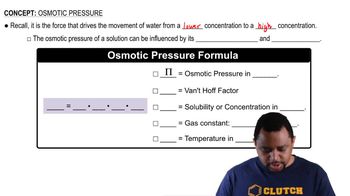(a) A 0.1044-g sample of an unknown monoprotic acid requires 22.10 mL of 0.0500 M NaOH to reach the end point. What is the molar mass of the unknown?
The osmotic pressure of a saturated solution of strontium sulfate at 25 C is 21 torr. What is the solubility product of this salt at 25 C?

Verified Solution
Key Concepts
Osmotic Pressure

Solubility Product (Ksp)

Dissociation of Ionic Compounds

(b) As the acid is titrated, the pH of the solution after the addition of 11.05 mL of the base is 4.89. What is the Ka for the acid?
What is the pH at 25 C of water saturated with CO2 at a partial pressure of 1.10 atm? The Henry's law constant for CO2 at 25 C is 3.1 * 10-2 mol>L@atm.
A concentration of 10–100 parts per billion (by mass) of Ag+ is an effective disinfectant in swimming pools. However, if the concentration exceeds this range, the Ag+ can cause adverse health effects. One way to maintain an appropriate concentration of Ag+ is to add a slightly soluble salt to the pool. Using Ksp values from Appendix D, calculate the equilibrium concentration of Ag+ in parts per billion that would exist in equilibrium with (c) AgI.
Fluoridation of drinking water is employed in many places to aid in the prevention of tooth decay. Typically. the Fion concentration is adjusted to about 1 ppm. Some water supplies are also 'hard'; that is, they contain certain cations such as Ca2 + that interfere with the action of soap. Consider a case where the concentration of Ca2 + is 8 ppm. Could a precipitate of CaF2 form under these conditions? (Make any necessary approximations.)
Baking soda (sodium bicarbonate, NaHCO3) reacts with acids in foods to form carbonic acid 1H2CO32, which in turn decomposes to water and carbon dioxide gas. In a cake batter, the CO21g2 forms bubbles and causes the cake to rise. (a) A rule of thumb in baking is that 1/2 teaspoon of baking soda is neutralized by one cup of sour milk. The acid component in sour milk is lactic acid, CH3CH1OH2COOH. Write the chemical equation for this neutralization reaction.
